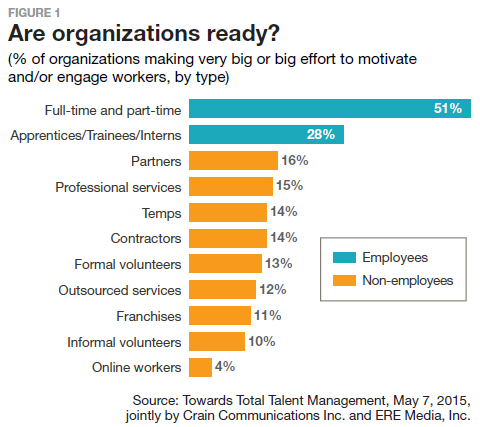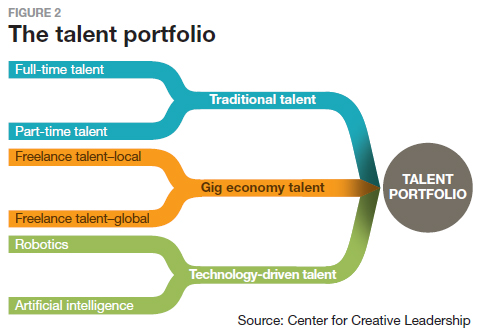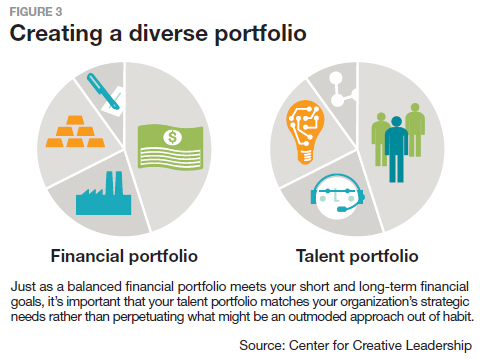Aligning People, Processes, and Technology for the New Future World of Work in the “Gig Economy”

In the future world of work, a dizzying mix of robotics, artificial intelligence, freelance workers and full-time employees will all be essential to achieving business objectives, and to thrive in this new environment, organizations will need a new portfolio-based talent strategy.
Workforce Agility & Labor Flexibility
Exponential change is at our doorstep.
The World Economic Forum states that we are on the brink of experiencing a Fourth Industrial Revolution.
Some predict that we will undergo changes in multiple aspects of our lives in the next five years on a scale comparable to what we experienced in the previous 50 years.
There are good reasons for supply chain managers to pay attention to these changes.
According to research by McKinsey, companies with more agile supply-chain practices had service levels that were seven percentage points higher, and inventory levels that were 23 days lower, than their less agile peers did.
One of the key findings reflected the importance of workforce agility and labor flexibility in achieving these results.
We’re already beginning to see the early signs of the unprecedented velocity, scope, and impact of these changes on the workplace.
In all likelihood, in just a few short years, the talent landscape will look completely different for all functions within a company.
While the specifics may vary by industry, no organization is immune to some of the major shifts that are already underway.
This article focuses on the effect that these rapid, unpredictable, paradoxical and tangled changes - what we’re calling RUPT - will have on the talent landscape.
It explores how organizations and individual leaders can adapt to - and leverage - them to turn an otherwise overwhelming experience into an opportunity to thrive amidst the turbulence.
By getting a better grasp of what’s coming, we contend that an organization can ride the wave to a more agile and prosperous future instead of being pulled under by the current.
Everything is Changing
Talent in the digital era is changing in the five overarching ways outlined below:
- How the work gets done? The work we do on a daily basis is becoming more team-based, project-based and multi-disciplinary.
- When and where the work gets done? Work is increasingly global, virtual and can happen at any time and any place. We’re also seeing a rise in temporary teams, coming together for a specific goal and then dispersing; this is sometimes referred to as the “Hollywood model” of teamwork because it resembles how a film production team comes together.
- Who does the work? Projects are more often staffed with a mix of internal and external talent that is increasingly diverse in age and experience.
- What does the work? Within the next five years, technology could be performing as much as 30% of tasks commonly performed by people in today’s workplace.
- Tools for managing the talent. Big data, predictive analytics and the rise of talent platforms such as Seek and Upwork put powerful tools in the hands of managers - if used properly.
For this article, we will focus primarily on No. 3: who does the work? And we’ll advise on how our thinking should shift when it comes to talent portfolios.
The Rise of the “Gig Economy”
The gig economy is also known as contingent work, sharing economy, agile talent, non-traditional work relationships or alternate forms of employment.
Today, there are nearly 41 million independent workers in the United States alone, according to the latest State of Independence Report from MBO Partners. That’s more than 30% of the nation’s private workforce.
A recent report from Randstad predicts that by 2019, up to half of the workers in the U.S. will be working in a contract, temporary, consultant or freelance capacity. What’s more, they predict that by 2025, up to 70% of people could be part of this gig economy.
And while Uber and Airbnb have received most of the attention from the press, other “digital disruptors” of the status quo include Lyft (ride sharing), UpCounsel (legal experts), Instacart (shopping and delivery) and TaskRabbit (odd jobs), to name just a few.
Of course, it’s not just a U.S. phenomenon.
In our interconnected, globalized world, the Gig Economy is a widespread phenomenon that promises to touch every corner of the globe. Part of this seismic shift is spurred by employers (Figure 1).
Randstad found that nearly half of employers express a greater commitment to building and utilizing an agile workforce, which is a 155% increase over the last four years. But the shift is also being driven by employees opting to become independent workers.
According to MBO Partners, more than 75% of independents say they are happier working on their own, and almost half of independent workers report feeling more secure than in a traditional employment relationship. McKinsey found that as many as one in six people in traditional jobs would like to switch to being primarily independent.
And that could be a conservative estimate - we surveyed more than 200 CCL program alumni and found that one in five aspires to full-time independent work.
A whopping 56% of people we surveyed expressed interest in eventually working independently. The majority of them hoped to pursue part-time independent work, but almost 40% said they would like to make it a full-time arrangement.
Why? Here are the top three reasons people told us they are interested in freelance work:
- pursuing their interests;
- freedom and independence; and
- flexibility.
These independents are not the “temp” workers of previous decades. They can be found in every level of the organization - from unskilled positions to C-suite roles. The trend has shifted strongly toward individuals pursuing independent careers by choice, not a necessity.
The search for greater freedom, flexibility, and fulfillment leads some independents to describe their work as more of a calling than a career. This scenario appeals to an increasingly diverse set of ages and experience levels: Freshly minted graduates bypassing corporate life altogether to establish themselves as solopreneurs, mid-career professionals ready to call their own shots and pursue their passions, and individuals approaching retirement looking to give something back with their accumulated wisdom and experience.
And, it’s some of the best, brightest and highest-paid talent trending into this line of work. MBO Partners annual survey sees sharp growth in independent workers taking in more than six-figures in revenue. A recent IBM study found independent workers to be both highly innovative and more engaged than most full-time employees.
Even if only a fraction of current employees actually make the jump to being independent, most organizations aren’t ready for such a sizeable disruption, especially if it affects their top talent.
Despite a growing desire to work independently, most organizations aren’t thinking about how to retain existing employees who are considering independent work, and few are putting any effort into motivating and engaging existing or future freelance workers.
Instead, most companies are operating in a decades-old paradigm when it comes to talent. New ways of thinking about - and managing - talent are desperately needed to compete in the digital era. Organizations who can successfully engage and integrate the diverse motivations, skills, and experiences of the growing talent base in the gig economy can tap into more of what it has to offer and gain a talent advantage over their competitors.
One emerging area to explore is technology-enabled talent platforms such as Tongal, Topcoder and Mechanical Turk (which the authors have used). These are accelerating the disruption of the status quo for supply chain managers and creating a new era of business turbulence, which we characterize using the acronym RUPT for rapid, unpredictable, paradoxical change.
They enable people to have more control over how they work - whether that’s a better balance between work and home, choosing passion-driven projects or being their own boss. The gig economy makes all of those things possible on a scale like never before.
The question supply chain managers must ask is whether they will leverage these and other talent platforms to successfully manage their entire talent portfolio, or leave that responsibility to the hiring departments or procurement?
Beyond the Band-Aid
If you think about short-term talent at all, chances are you think of it as a Band-Aid to address an immediate need. Using independent workers to cover a brief talent gap or when an occasional, specialized skill is required might make sense, but this limited approach can leave a lot on the table.
There’s much more to be gained by taking a longer-term perspective on short-term talent.
Following are five ways your organization could take a wider view of short-term or independent talent.
- Experts in residence: Having a “secret weapon” for strategically important work or using outside talent to raise a team’s collective capabilities could be a significant asset to your organization.
- Mentors for hire: Consider finding someone who could nurture the skills of less experienced employees to prepare them for bigger responsibilities.
- Brand ambassadors: Successful freelancers form strong networks with others in their industry and/or profession, and if one of them has a positive experience with your organization, it could help you tap into a whole pool of people that could dramatically enhance your current capabilities. Of course, the opposite can also occur.
- Cultural catalysts: Finding someone who can bring an innovative mindset or exemplify a particular set of values might help you make an important cultural shift.
- Transitional talent: The Rent-a-CXO concept is trending. An independent worker could be the right move if your organization needs to grow rapidly without derailing or needs to weather an unexpected transition.
This list isn’t exhaustive and only touches on some of the possibilities for tapping into an often-underutilized source of talent. We encourage you to further imagine - and experiment with - new approaches to getting the most out of your short-term talent.
Building and Managing a Talent Portfolio
The need for new ways of thinking about talent goes beyond the gig economy. To position your organization and its talent for optimal success in a RUPT world, we recommend that you take a strategic approach that we call “Talent Portfolio Agility,” a term we have trademarked.
We define Talent Portfolio Agility as the organizational capability and mindset of accomplishing work through a portfolio of talent enabled by agile talent processes.
This has both a “what” and a “how” component.
For the “what” of Talent Portfolio Agility, we suggest thinking about your overall talent equation as part of a three-pronged portfolio, each with two subsets (Figure 2).
The first prong is the traditional talent - your current full-time and part-time workforce, which likely makes up the bulk of your existing portfolio.
The second prong is gig economy talent, including freelance talent, both locally and globally.
And the third - which could be the subject of its own article - is technology-driven talent, including robotics and artificial intelligence.
Just like diversifying and creating an agile financial portfolio, there are important reasons to consider creating a diverse talent portfolio that is sustained by its agile mindset, processes, and technology (Figure 3).
Before venturing further, ask the following questions about your talent that you might also consider with regards to your finances:
- What are we trying to accomplish?
- What is our risk tolerance?
- What is the right mix of assets?
- How do we anticipate and adjust to changes in the market?
- How do we measure our performance and the performance of our various talent?
As you figure out what works best for your organization, also consider questions such as:
- What are the technical and legal issues we should consider?
- What cultural and structural issues might affect our approach?
- Are there issues/opportunities unique to our industry to take into account?
Figuring out the right mix of talent assets for your organization will take time and effort. But by carefully considering the questions we’ve outlined, thinking about how to better engage current employees and independent workers and exploring how to integrate human talent with technology-driven talent, you can create the needed change in your talent portfolio.
These shifts might sound intimidating, or even overwhelming. In order to succeed, you’ll need to also consider the “how” of Talent Portfolio Agility, Specifically, investing in five core capabilities associated with organizational agility will enable your organization to nimbly adapt and adjust to these new realities.
As an individual and an organization, ask yourself how well you:
- anticipate change;
- generate confidence;
- initiate action;
- liberate thinking; and
- evaluate results
Identify the biggest gaps between where you are and where you need to be. Ask yourself which elements you should prioritize and then figure out what makes sense to tackle first. Our Talent Portfolio Agility Index can provide you with an initial assessment of your organization’s baseline measurements in each area of capability.
The TPA Index captures a snapshot of how agile the talent management processes, policies, and practices are within organizations you have served or are currently involved with now. A deeper audit of these capabilities can pinpoint specific areas for intervention and the systems, tools, and processes required for a sustainable change in your organization’s talent strategy and practices.
From Talent Management to Talent Portfolio Management
The gig economy is demanding a fundamental shift in the typical talent management philosophy that historically focused on full-time employees to talent portfolio management, which represents both internal and external talent.
How an organization manages the internal-external partnership has a lot to do with the successful management of the HR processes, policies, and philosophies supporting an entire Talent Portfolio. Some organizations have problems because they have treated contingent workers as totally separate and not “equal” to internal employees.
The culture of most organizations would never allow treating free-agent talent like internal employee talent. Supply chain management leaders need to develop their managers to fundamentally change how they think about and manage the entire talent portfolio.
In many organizations, procurement is often responsible for negotiating the contract with contingent workers, with the focus primarily on cost control and limited focus on the talent portfolio value that the contingent works to bring to the organization. Hiring managers are expected to manage the relationship with gigsters as part of their talent portfolio.
The challenge for procurement is to work with HR and hiring managers on a more collaborative approach to acquiring talent in the gig economy. Talent platforms like Tongal will likely require procurement, marketing, and human resources to work together to access and coordinate a new talent portfolio which includes on-demand talent markets and crowdsourced competitions and more traditional in-house teams and outside advertising and creative agencies.
Winning in the Gig Economy
The world of work is changing. Like it or not, we’re destined for a more complicated and complex future. Most organizations don’t fully grasp the massive shifts already underway and aren’t doing enough to adjust. Instead, they’re functioning in a state of complacency or are paralyzed with inaction by the immensity of change they see coming. The window of opportunity is closing quickly.
Supply chain managers have the opportunity to drive the agility and rapid innovation necessary to compete in the gig economy, and even demonstrate the change readiness that affects the entire organization. Yet, transformations like this are by no means easy to achieve, even if most executives know they must act.
Organizations that figure out the right mix of talent, align their processes or policies to reinforce a talent portfolio agility mindset and then manage that talent in an agile manner, will likely gain a competitive advantage. The frameworks proposed in this article help to guide the choices that supply chain managers must make to help transform their organizations in the face of the gig economy challenges.
You can start by exploring some of the questions we’ve raised in this article. Share them with your colleagues and consider the appropriate short- and long-term approaches to take. Understand the motivations of current and future independent workers, evaluate how you can work better and more wisely with them and think about how you can integrate a longer-term perspective with multiple types of short-term talent - including technology-driven talent.
Talent portfolio agility can help organizations that want to adapt and thrive in a new world of work by reducing vulnerability to shifts in the market and maximizing all forms of talent, unlike traditional models of talent management. Achieving talent portfolio agility is a long and challenging journey, but the head-in-the-sand alternative will leave you behind your competitors.
By understanding the gig economy and re-thinking how to best attract, engage and retain short-term talent, you can break away from old, outdated methods. Creating a more agile and adaptive workforce doesn’t have to mean a dramatic organizational overhaul. It will take time, and will vary by industry, location, organization, and function - but it can be done.
Visit Find Your Future Fluency It’s one thing to imagine the future. It’s quite another to engineer it.
About the Authors
Nicholas Horney is the founder of Agility Consulting and Training and is the co-author of “Focused, Fast and Flexible: Creating Agility Advantage in a VUCA World; Managing Change in Organizations;” and “Project Change Management.” He can be reached at [email protected].
George Hallenbeck is the director of commercialization at the Center for Creative Leadership (CCL). He has authored or co-authored eight books including “Learning Agility: Unlock the Lessons of Experience and Compass: Your Guide for Leadership Development and Coaching.” He can be reached at [email protected].
Stephen Bateman is a senior project manager at the Center for Creative Leadership (CCL), working in the Commercialization & Innovation group. He can be reached at [email protected].
Related White Paper
Redefining Talent for the New World of Work
This white paper focuses on the effect that rapid, unpredictable, paradoxical, and tangled changes will have on the talent landscape, and it explores how organizations and individual leaders can adapt to and leverage these changes to turn what could otherwise be an overwhelming experience into an opportunity to thrive amidst the turbulence. Download Now!
Article Topics
Center for Creative Leadership News & Resources
The Most Telling Leadership Quality of a Great Leader is How Well They Treat Others Aligning People, Processes, and Technology for the New Future World of Work in the “Gig Economy” Redefining Talent for the New World of Work Truth and Courage: Implementing a Coaching Culture LeBron on Leadership Kobe Bryant and Jeff Stibel Unveil $100 Million Media, Technology, and Data Venture Capital FundLatest in Business
Ranking the Top 20 Women in Supply Chain TIm Cook Says Apple Plans to Increase Investments in Vietnam Amazon Logistics’ Growth Shakes Up Shipping Industry in 2023 Spotlight Startup: Cart.com is Reimagining Logistics Walmart and Swisslog Expand Partnership with New Texas Facility Nissan Channels Tesla With Its Latest Manufacturing Process U.S. Manufacturing Gains Momentum After Another Strong Month More Business

















